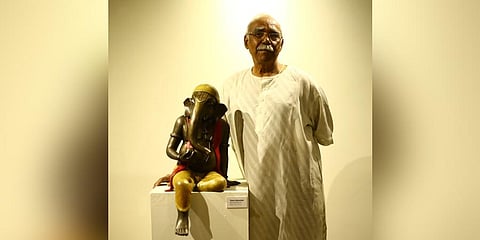

HYDERABAD: Patina, the thin oxide layer on the surface of a bronze object, is akin to what iron gains as rust. Interestingly, it’s much desired and then designed to give that unique look to several artefacts. Artists practise this often. At Kalakriti Art Gallery, the ongoing art exhibition titled ‘Bronzed – From Paint to Patina’ is showcasing statuettes in bronze layered with patina by three noted artists: the late Ram Kumar, Thota Vaikuntam and Krishen Khanna.
Though it’s a slow process, the right expertise and good craftsmanship the results can be really good and the opuses glazing. That’s how the artists collaborate with skilled artisans to create the desired effect. Informs city-based celebrated artist Thota Vaikuntam, “It took a month for me to complete each sculpture. I created ten but only seven are being showcased at this exhibition. I am essentially a painter, not a sculptor. But a friend in Delhi got me interested in sculpting and I indulge into it sometimes if not often.”
Thota’s seven artefacts show variety much like his paintings done in vibrant colours that represent Telangana. One of the works represents mother and child with the woman clad in a scarlet sari holding her baby. She’s decked up in jewellery, and the entire figurine glows implying the use of patina. At the same time, Ram Kumar works have sleek silhouettes with a finesses which looks almost perfect. The sheen balances the palette he used.
Other than the artist and the craftsmen it was Bronze Age London, an old casting foundry in the UK known for its expertise in patination responsible for the final design and texture of the oeuvre. Adds Vaikuntam, “Once the final model was created it was sent to London to be cast in bronze.” The process of lost wax was used for creating the bronze casting. The challenge was to ensure that the patina had to be in sync with the palette that the artist used. The various combinations of chemicals interact at a high temperature on the finished bronze causing the same to react differently and change its hue.
The exhibition is on till March 8
saima@newindianexpress